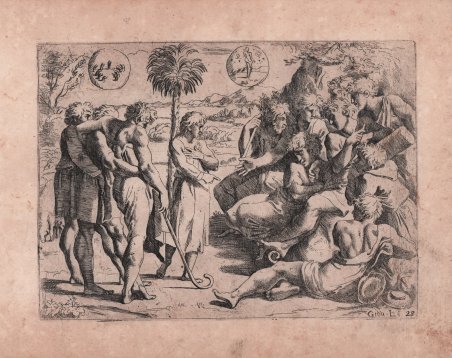Acquaforte, circa 1607, firmata in lastra. Bellissima prova, con pieni margini, alcuni strappi nei margini bianchi dove sono presenti delle leggere gore d’acqua, che non intaccano la parte incisa, per il resto in buono stato di conservazione.La tavola appartiene alla famosa Bibbia di Raffaello, incisa da Sisto Badalocchio e Giovanni Lanfranco, dal titolo “Historia del Testamento Vecchio dipinta in Roma nel Vaticano da Raffaello da Urbino et intagliata in rame da Sisto Badalocchi et Giovanni Lanfranchi Parmigian. Al Sig. Annibale Carracci. In Roma appresso a Giovanni Orlandi. Con licenza de' Superiori. 1607”.La serie fu realizzata a Roma intorno al 1607, dove i due artisti erano allievi di Annibale Carracci; 28 delle tavole sono incise da Lanfranco, mentre 23 opera di Badalocchio. Le opere derivano dagli affreschi di Raffaello nella loggia del Vaticano.Scrive Michael Bury, 'The Print in Italy', BM 2001, cat.90: “The etchings reverse Raphael's compositions. Mussini noted a tendency to simplification and alteration, especially in Badalocchio (Mussini, 1979, p.61); Borea suggested that the prints are the result of some critical reflection (1986, p.xvi). In the plate shown here, the spatial structure is substantially altered by cutting the height of the scene, making Isaac's head almost touch the top edge. This is in line with what is done in many others, by Sisto Badalocchio as well as Lanfranco. The effect is to increase the size and impact of the figures, for it is their movements and their relationships with one another that are at the centre of attention.The long dedication to Annibale Carracci reveals that the drawings had been made during the previous summer, while the Pope was away from the Vatican. Annibale's illness had prevented Badalocchio and Lanfranco from studying with him, and, keen to pursue their studies during this period, they had turned to the work of Raphael, whom Annibale always praised so much. They had now decided to publish their drawings for the benefit of young students of painting who live far away, executing them in etching 'for greater speed' ("per maggiore prestezza"). It is pointed out that not everyone has appreciated the Loggie frescoes as much as they deserve, believing them to have only been designed by Raphael; however for the variety of the inventions and for their sublime subjects they are worthy of the highest regard. Ginzburg Carignani (1996, p.130 and n.112) has shown that the preface was not in fact written by the two pupils, but by G.B.Agucchi (1570-1632) the patron and writer on art. Agucchi was a great champion of the Carracci and of Annibale in particular, seeing them as the reformers who had restored painting to the true path marked out first by the ancients and then, in modern times, by Raphael. Plate of the Raphael Bible etched by Badalocchio and Lanfranco, titled “Historia del Testamento Vecchio dipinta in Roma nel Vaticano da Raffaello da Urbino et intagliata in rame da Sisto Badalocchi et Giovanni Lanfranchi Parmigian. Al Sig. Annibale Carracci. In Roma appresso a Giovanni Orlandi. Con licenza de' Superiori. 1607”.The series consists of 54 plates, a frontispiece and three etched plates with dedicatory text to Annibale Carracci and 50 plates after Raphael that are numbered from 5 to 54.The set was made when the two etchers were both young pupils of Carracci in Rome in 1607 and were said to have been made to try to lift him out of depression; 28 plates are by Lanfranco (Bartsch XVIII.345.1 to 28) and 23 (including the frontispiece) by Badalocchio (Bartsch XVIII.354.1 to 23).Michael Bury, 'The Print in Italy', BM 2001, cat.90: “The etchings reverse Raphael's compositions. Mussini noted a tendency to simplification and alteration, especially in Badalocchio (Mussini, 1979, p.61); Borea suggested that the prints are the result of some critical reflection (1986, p.xvi). In the plate shown here, the spatial structure is substantially altered by cutting the height of the scene, making Isaac's head almost touch the top edge. This is in line with what is done in many others, by Sisto Badalocchio as well as Lanfranco. The effect is to increase the size and impact of the figures, for it is their movements and their relationships with one another that are at the centre of attention.The long dedication to Annibale Carracci reveals that the drawings had been made during the previous summer, while the Pope was away from the Vatican. Annibale's illness had prevented Badalocchio and Lanfranco from studying with him, and, keen to pursue their studies during this period, they had turned to the work of Raphael, whom Annibale always praised so much. They had now decided to publish their drawings for the benefit of young students of painting who live far away, executing them in etching 'for greater speed' ("per maggiore prestezza"). It is pointed out that not everyone has appreciated the Loggie frescoes as much as they deserve, believing them to have only been designed by Raphael; however for the variety of the inventions and for their sublime subjects they are worthy of the highest regard. Ginzburg Carignani (1996, p.130 and n.112) has shown that the preface was not in fact written by the two pupils, but by G.B.Agucchi (1570-1632) the patron and writer on art. Agucchi was a great champion of the Carracci and of Annibale in particular, seeing them as the reformers who had restored painting to the true path marked out first by the ancients and then, in modern times, by Raphael.Etching, printed on contemporary laid paper, with full margins showing tears at waterstains, otherwise good condition. Cfr.

Scopri come utilizzare
Scopri come utilizzare

